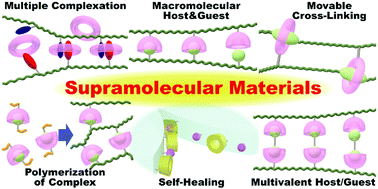当前位置:
X-MOL 学术
›
Chem. Commun.
›
论文详情
Our official English website, www.x-mol.net, welcomes your feedback! (Note: you will need to create a separate account there.)
Supramolecular self-healing materials from non-covalent cross-linking host-guest interactions.
Chemical Communications ( IF 4.9 ) Pub Date : 2020-04-06 , DOI: 10.1039/d0cc00672f Garry Sinawang 1 , Motofumi Osaki , Yoshinori Takashima , Hiroyasu Yamaguchi , Akira Harada
Chemical Communications ( IF 4.9 ) Pub Date : 2020-04-06 , DOI: 10.1039/d0cc00672f Garry Sinawang 1 , Motofumi Osaki , Yoshinori Takashima , Hiroyasu Yamaguchi , Akira Harada
Affiliation

|
The introduction of non-covalent bonds is effective for achieving self-healing properties because they can be controlled reversibly. One approach to introduce these bonds into supramolecular materials is use of host-guest interactions. This feature article summarizes the development of supramolecular materials constructed by non-covalent cross-linking through several approaches, such as host-guest interactions between host polymers and guest polymers, 1 : 2-type host-guest interactions, and host-guest interactions from the polymerization of host-guest inclusion complexes. Host-guest interactions show self-healing functions while also enabling stimuli-responsiveness (redox, pH, and temperature). The self-healing function of supramolecular materials is achieved by stress dispersion arising from host-guest interactions when stress is applied. Reversible bonds based on host-guest interactions have tremendous potential to expand the variety of functional materials.
中文翻译:

来自非共价交联宿主-客体相互作用的超分子自修复材料。
非共价键的引入对于实现自愈性能是有效的,因为它们可以被可逆地控制。将这些键引入超分子材料的一种方法是使用宿主-客体相互作用。该专题文章概述了通过非共价交联通过多种方法构建的超分子材料的发展,例如主体聚合物与客体聚合物之间的主体-客体相互作用,1:2-型主体-客体相互作用以及来自主客体包合物的聚合。宿主-客体相互作用显示出自我修复功能,同时还实现了刺激响应(氧化还原,pH和温度)。超分子材料的自我修复功能是通过在施加应力时由主客体相互作用产生的应力分散来实现的。
更新日期:2020-04-22
中文翻译:

来自非共价交联宿主-客体相互作用的超分子自修复材料。
非共价键的引入对于实现自愈性能是有效的,因为它们可以被可逆地控制。将这些键引入超分子材料的一种方法是使用宿主-客体相互作用。该专题文章概述了通过非共价交联通过多种方法构建的超分子材料的发展,例如主体聚合物与客体聚合物之间的主体-客体相互作用,1:2-型主体-客体相互作用以及来自主客体包合物的聚合。宿主-客体相互作用显示出自我修复功能,同时还实现了刺激响应(氧化还原,pH和温度)。超分子材料的自我修复功能是通过在施加应力时由主客体相互作用产生的应力分散来实现的。



























 京公网安备 11010802027423号
京公网安备 11010802027423号